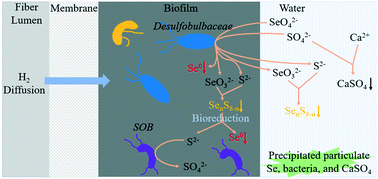Understanding the composition and spatial distribution of biological selenate reduction products for potential selenium recovery†
Abstract
Selenate is a common contaminant in agricultural drainage from areas with seleniferous soils. Microbes can convert selenate to elemental selenium nanoparticles, which may be recovered as a valuable resource. One challenge in the recovery of selenium from agricultural drainage is the coexistence of sulfate at very high concentrations. Studies have shown that sulfate may inhibit selenate reduction and lead to the precipitation of selenium sulfides, thus hindering the recovery of elemental selenium nanoparticles. It was found in this work that the hydraulic retention time (HRT) determined the effects of sulfate on selenate reduction by controlling the composition and spatial distribution of the selenium products in a H2-based membrane biofilm reactor. At a HRT of 0.28 days, 99% of selenate was reduced to elemental selenium nanoparticles precipitated in the reactor and suspended in effluent, which was desirable for recovery. When the HRT was decreased to 0.14 days or smaller, selenium sulfides became the dominant particulate selenium product in the effluent. Interestingly, elemental selenium was always the dominant particulate selenium product in the biofilm regardless of HRT owing to further biological reduction of selenium sulfides to elemental selenium and sulfide. At HRTs of 0.28 and 0.14 days, famous selenate and selenite reducers such as Rhodocyclaceae (including Azospira oryzae) and Rhizobium sp. were enriched in the biofilm. Decreasing HRT to 0.07 days resulted in electron donor limitation, which further led to the biofilm dominated by Desulfobulbaceae that is well known for its ability to reduce sulfur and selenium oxyanions and the enrichment of sulfide-oxidizing bacteria.



 Please wait while we load your content...
Please wait while we load your content...